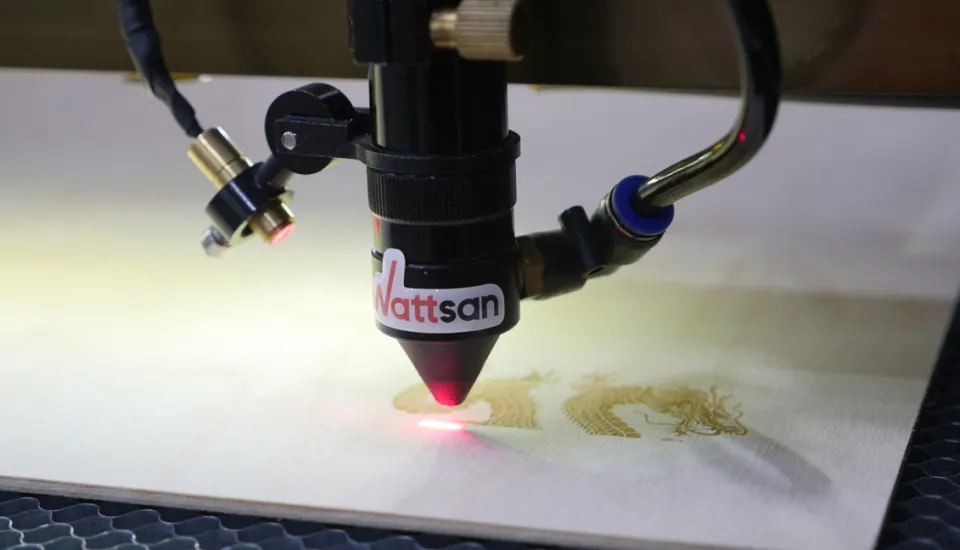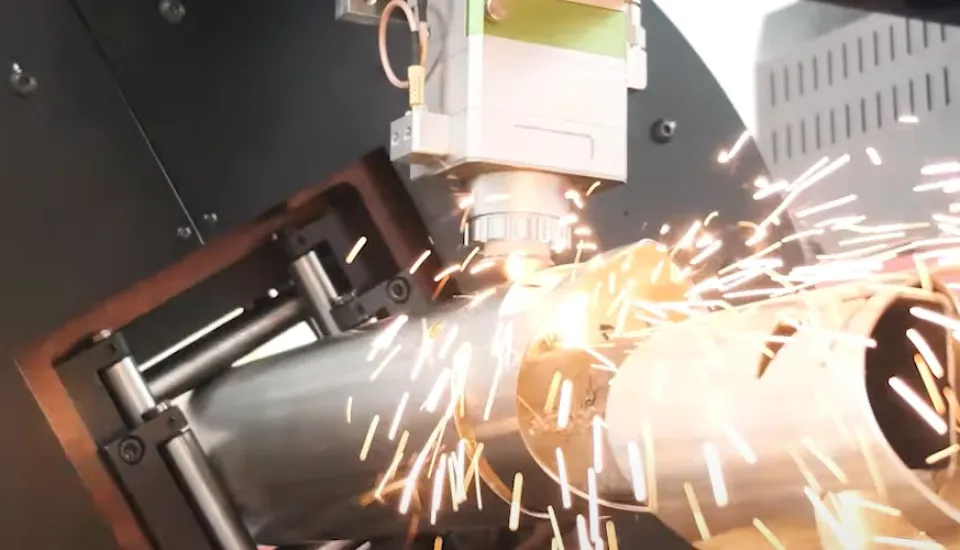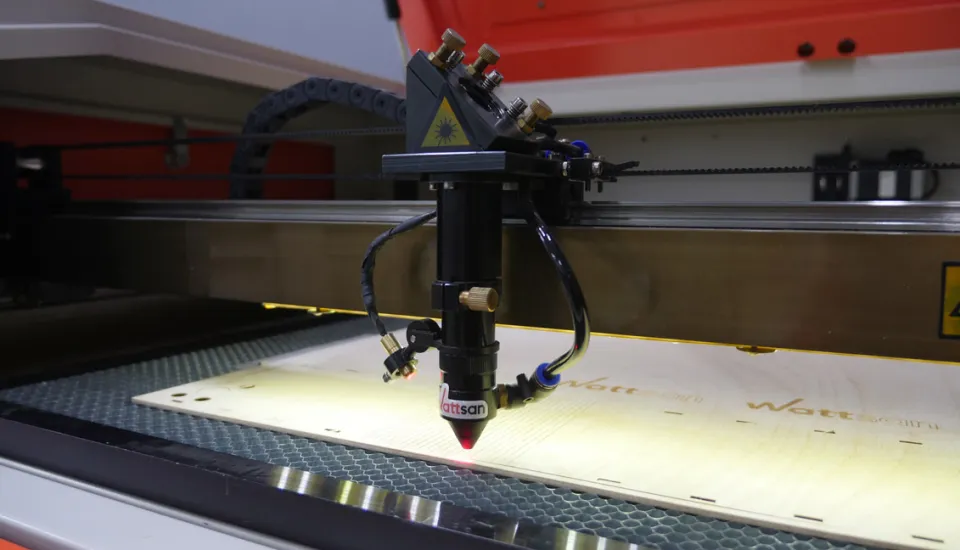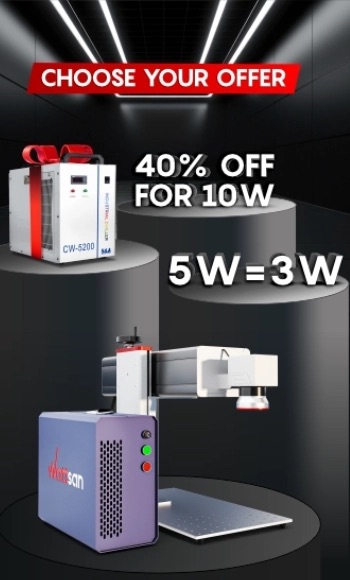What is a laser marker?
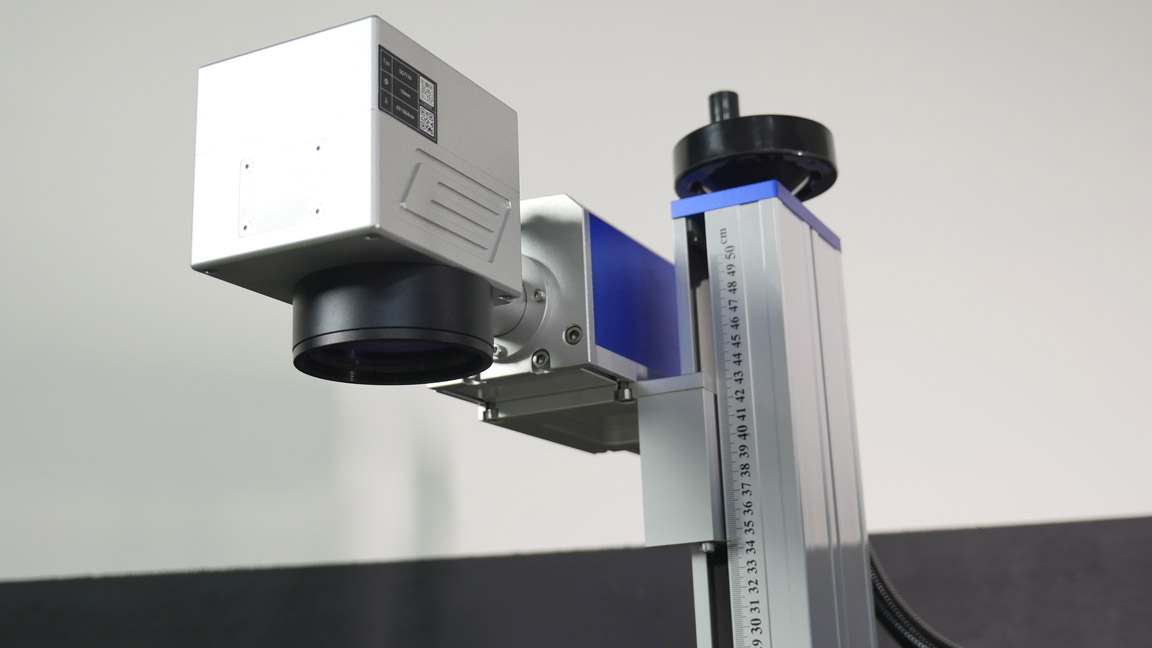
Laser marker is a compact high speed machine tool, which applies graphic information in the form of marking and engraving onto various materials, from wood and leather to plastics and metals.
With a laser marker, you can print such information as bar-codes and QR-codes, logos, and serial numbers. It is also used in the jewelry industry and for branding souvenirs and manufacturing microchips.
A laser marker is a durable device that perform its tasks well and lasts for about 10 years, but only if you pay enough attention to the quality of the manufacturer.
In this article, we will tell you how a laser marker works, what the difference between CO2 machine tools and fiber optic markers for metal is, where you can use them, and how to choose such a machine.
Advantages of a fiber optic marker:
- Working speed up to 7000 mm/sec and above. To engrave small images or inscriptions takes less than a second, which allows you to set up highly productive inline production.
- Detailing up to 2500 DPI. Thanks to the small diameter of the laser beam, the engraving error is 0.01 mm, enabling images of any complexity and for jewelry and microscopic applications.
- Image durability. The applied image is not erased, moderately resistant to aggressive environments and mechanical stress.
- Low power consumption. Power consumption is similar to that of a kettle: approx. 600 Watt/hour.
- 24/7. The laser marker is designed to run non-stop around the clock.
- Easy use. No special expensive maintenance required.
- Compact size. The machine is compact and is easy to integrate into any production line.
- No defects. The software eliminates rejects and guarantees 100% product repeatability.
Operating principle of a marking machine
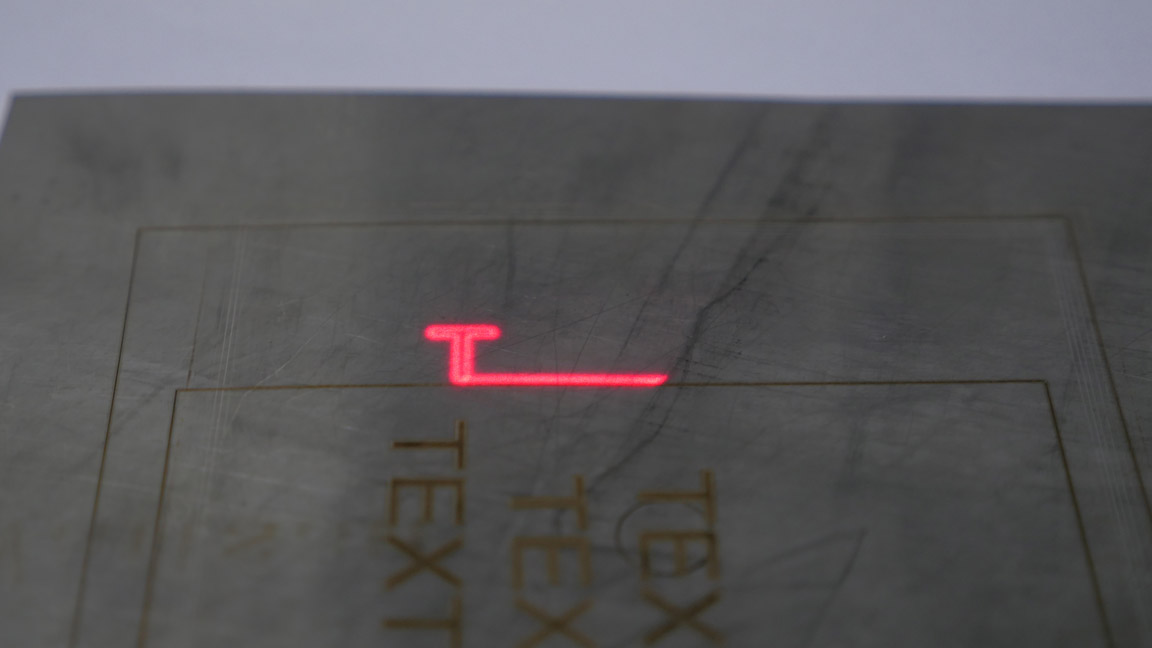
First, you need to prepare a vector layout and load it into a special programme that controls the laser marker. In this programme the operating parameters are set to achieve the desired result.
When the layout is ready, you place the workpiece on the worktable where the marker shows the future machining area for easier positioning. Then you press “Start”, and the machine generates laser emission in the laser marker source.
The machine then sends the laser beam to a galvanometer scanner or 'scanning head', which directs the laser beam to the desired point using two movable mirrors, one operating in the X-axis and the other in the Y-axis.
The scanner is equipped with an F-Theta lens that focuses the laser beam onto the surface of the material to be processed.
Remember to remove the protective cover from the lens before work. A closed protective cover causes damage to the lens during operation.
When the beam reaches the material, it thermally affects the top layer. If the impact is strong, it engraves; if it is weak, it marks.
Engraving is more resistant to various mechanical impacts and the influence of aggressive environments because it burns off the top layer of the material to a sufficient depth.
Marking, on the other hand, is not perceptible under the fingers, because it changes the properties of the top layer through rapid and intense heating without damaging the material and allowing for colour marking of stainless steel and titanium – temper colours (only with a fiber optic marker).
What materials can be laser engraved Stock Form
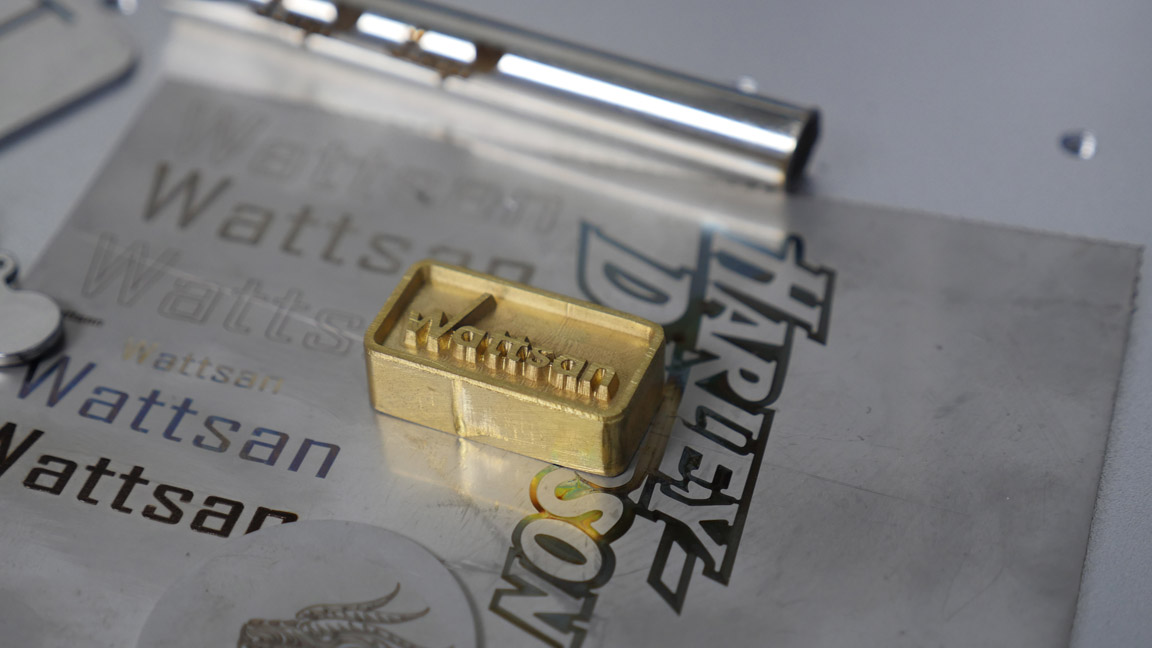
Most modern production materials can be engraved and marked:
- wood, plywood, MDF, chipboard, paper and cardboard, and any other wood-based materials;
- acrylic, ABS, PET, rubber, polyamide, soft-touch, polypropylene, polyurethane and other plastics, including carbon plastics and composites;
- fabric, leather, and faux leather;
- metals: ferrous metals, stainless steel, titanium, aluminium;
- glass and ceramics;
- painted products.
Install an exhaust system to work with plastics and other toxic materials!
Which material you machine can process depends on the emitter type. CO2 markers work with non-metallic materials, and fiber markers can process metals. Read more about this a little further on.
For wood we recommend to use a laser engraving machines.
What products can be made with a laser marker?
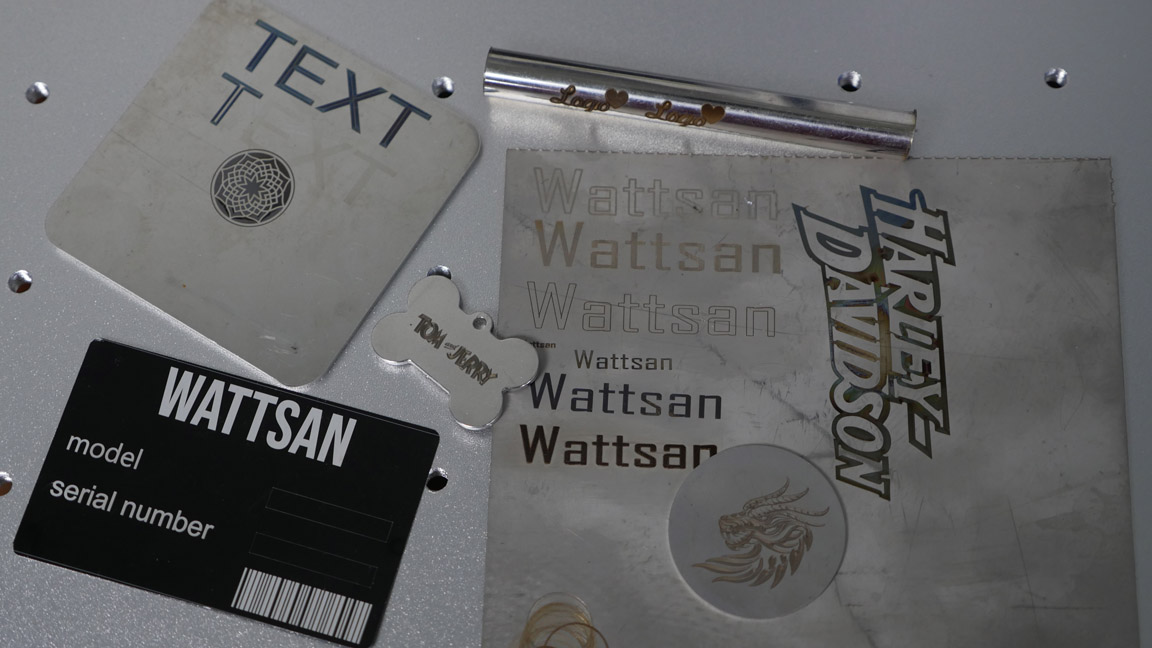
The main product of a laser marking machine is an image or inscription on a desired surface. Since lasers engrave and mark almost all materials, there is a wide range of applications:
- package labeling;
- bar-codes, QR codes, logos, serial numbers, and technical product data;
- souvenir production: engraving pendants, knives, thermoses, watches, pens, etc.;
- jewellery engraving;
- branding of products, e.g. brand engraving for restaurants: tables, burger and pizza boards, napkin holders, etc.;
- marking of machine parts and other equipment;
- marking of pipes and cables;
- production of nameplates, signs, and labels;
- marking computer keypad;
- marking of medical instruments and much more.
Do not use a laser marker to cut thick materials! This causes the mirrors of the scanner to overheat and fail. It is acceptable to cut thin foil on fiber markers or paper on CO2 machines.
Criteria for choosing a laser marking machine
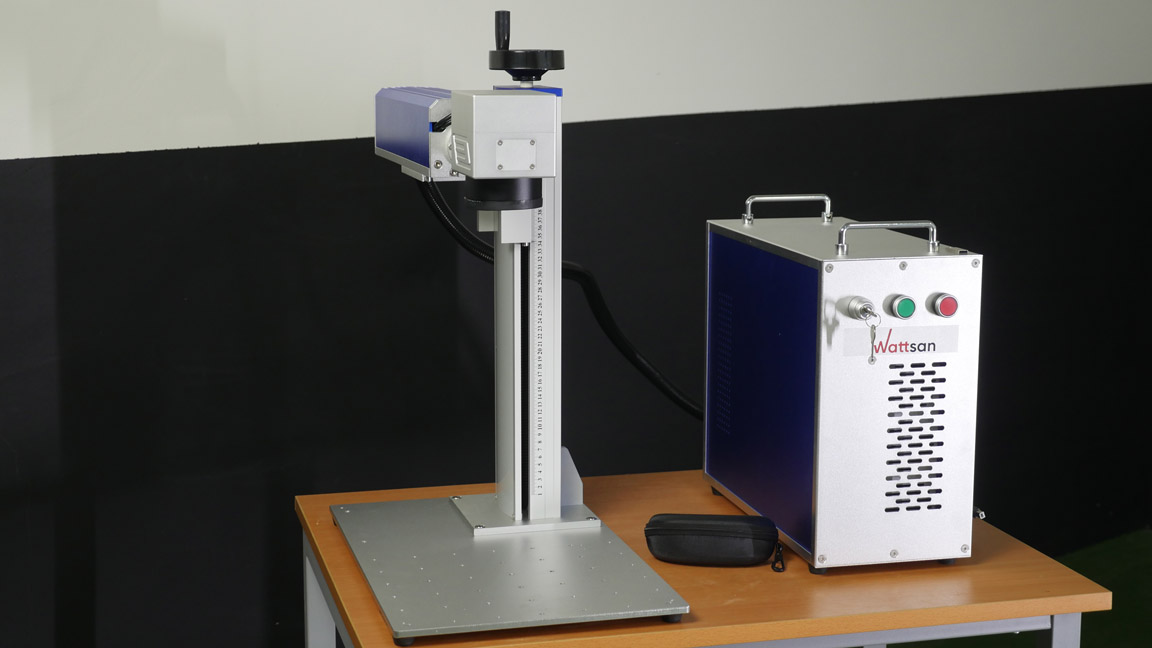
To choose a laser marker, you should consider the main parameters:
- laser source type;
- power;
- lens;
- machine design;
- scanner and controller;
- support and maintenance.
First, you should understand what materials you will engrave or mark. All selection criteria depend on this.
Laser marker emitter
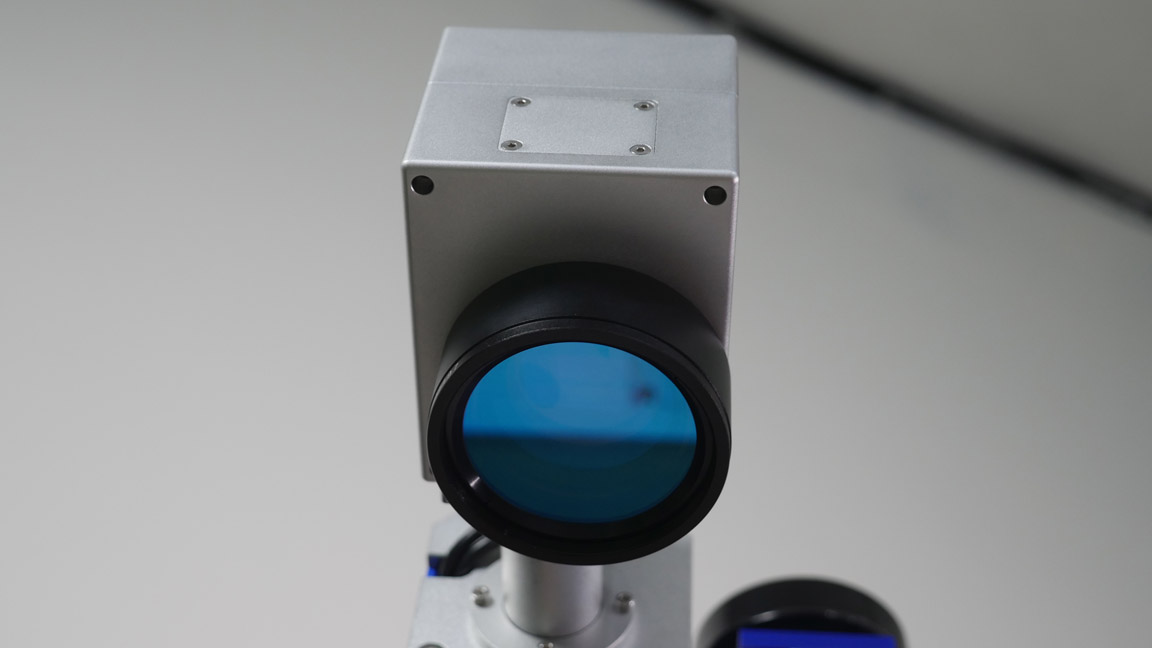
Types of laser marker emitters
There are two main types of emitters: carbon dioxide (CO2) and fiber optic. Carbon dioxide (CO2) emitters have a wavelength of 10600 nm or 9400 nm, far-infrared radiation, and the fiber optic emitters – 1064 nm, near IR radiation.
The wavelength determines which materials the emitter is able to work with.
СО2 emitters engrave and mark organic materials:
- plywood and all types of wood-based materials;
- paper and cardboard;
- leather and faux leather;
- fabric;
- glass and mirror;
- plastics and rubber;
- stone and ceramics.
Fiber optic emitters engrave and mark:
- metals (carbon steel, stainless steel, aluminium, titanium, etc);
- plastics and rubber;
- leather and faux leather.
To engrave metals with a CO2 laser, a special paste is used that is applied to the material in a thin layer. With this method, it is impossible to achieve high quality deep engraving of metals even if the operation is repeated several times.
Fiber markers are air-cooled whereas CO2 machines need water-cooling and therefore require additional equipment – a chiller.
Top most popular manufacturers of CO2 emitters
Generally, large laser tube manufacturers such as Lasea and Reci do not produce emitters for CO2 markers. They specialise in large CO2 laser machines, engravers and cutters.
For this reason, most laser markers are often equipped with a no-name emitter, which is essentially a pig in a poke. It can immediately come out of order or lose the declared power after only a month of use.
There is only one brand of emitters for CO2 markers that is rapidly gaining popularity - Yongli. These tubes last up to 10,000 hours and have low beam divergence and a small laser beam diameter.
Be sure to use a chiller to cool the laser tube for it to last the entire stated period. We recommend using S&A chillers.
A correctly adjusted high voltage unit also affects service life. Virmer engineers adjust the high voltage unit of the machine to the power of the laser tube before it is shipped to the customer.
As a CO2 laser tube is made of glass, it is very fragile. Be sure to check it upon receipt and choose a supplier who gives a warranty and conditions for replacing the laser tube if it arrives in a faulty condition.
Virmer guarantees the delivery of machines in fully operating condition.
Top most popular manufacturers of fiber optic emitters
- MaxPhotonics is a budget option for simple applications: applying serial numbers, technical information or simple one-color images such as a logo, making nameplates and signs.
- Raycus is suitable for more demanding applications, as it is more stable and reliable and provides evenly flowing. Marks a small number of simple shades on metal.
- IPG offers a wide range of colours on metals due to its wide frequency range. Shows the best pulse stability, accuracy, minimum laser beam spot, makes evenly marking, and is protected against reflections. In fact, it is the best emitter manufacturer today. Accordingly, it is also the most expensive.
Order a demonstration, and we will show how the emitter you are interested in works with the desired material. Contact our managers by +31208082045 or е-mail: info@virmer.com.
Emitter power
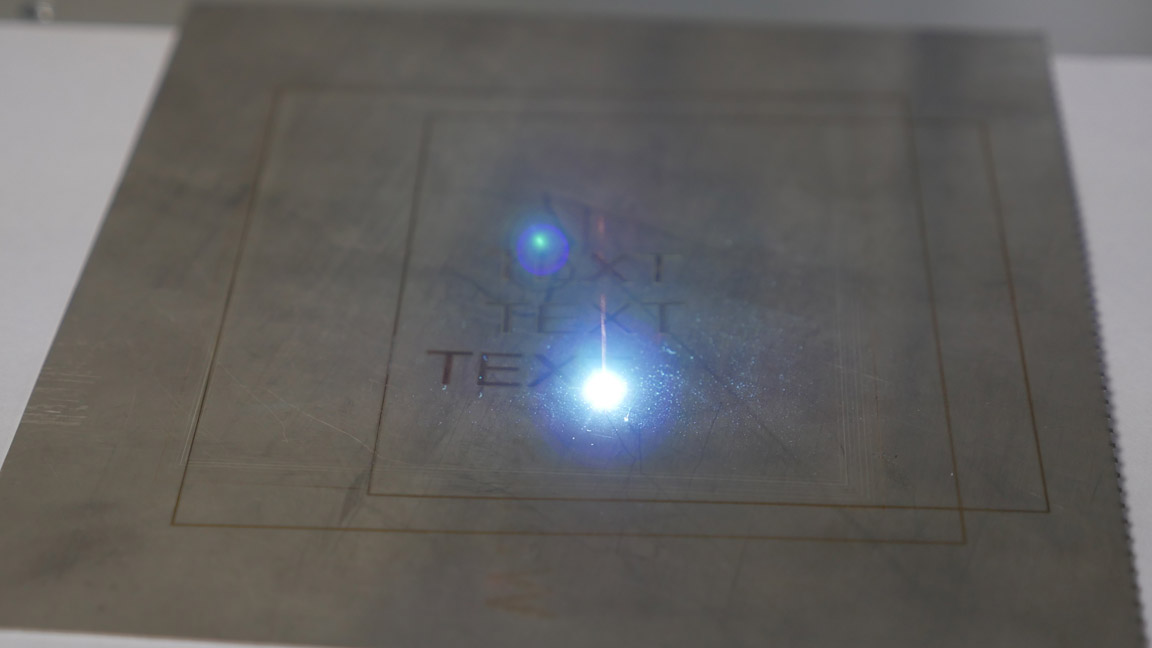
Laser markers usually have a power of 20-50 W, in rare cases up to 100 W. It would seem that the more power, the faster the machine runs, and in some cases this is indeed the case, but there are nuances. It all depends on the task at hand.
More power makes sense in 3 cases:
- High-speed engraving – the more powerful the emitter, the faster you can engrave. Speed is needed for inline production.
- Deep engraving. Of course, you can also engrave in depth with a 20 W emitter, but then you have to make several passes, which takes extra time. A 30 W emitter is the minimum required for such a task.
- Machining highly reflective metals. Efficient engraving on highly reflective metals such as silver requires a power of 50 W or more in order for the laser beam to overcome the reflection threshold and burn through the material.
However, if your main task is marking, including coloured marking, then the maximum required power is 30 W. Otherwise it is difficult to choose the correct parameters for the machine to mark evenly and not to burn through the material.
For coloured metal marking other parameters must also be considered: pulse frequency and stability, laser spot size, and Gaussian distribution. To find the right laser marker for your applications, please contact our managers, phone: +31208082045 or е-mail: info@virmer.com..
The speed, depth of work, and final result are also influenced by the lens.
Lens and working area size of the laser marker
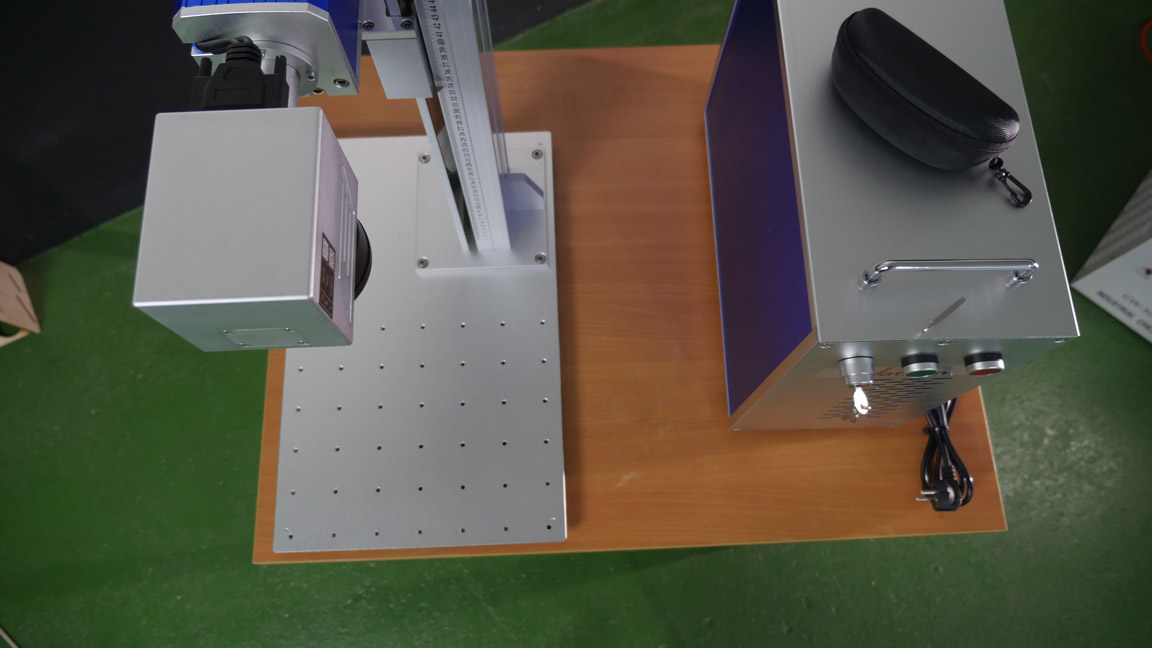
The lens focuses the laser beam, and its characteristics determine the size of the working area; the most popular are 110х110, 200х200 and 300х300 mm.
The lens determines not only the size of the working area but also the energy density per area.
The smaller the working area, the smaller the laser beam spot, i.e. the larger the energy density per area. This means the intensity of the treatment will be higher. And vice versa - the larger the size of the working area, the lower the energy density per area.
A 110x110 lens will work better in depth, e.g. you can do deep engraving and even volumetric engraving faster. This type of treatment removes the material layer by layer, and as a result a three-dimensional image is obtained. This is how souvenir coins and pendants are made.The more powerful your emitter is, the faster you can do this task.
The 200x200 and especially the 300x300 mm lenses have a correspondingly large working area, but lower impact intensity. These lenses are better suited for marking and are particularly often used when large objects and workpieces need to be engraved.
You can see a direct correlation between the result of performance and the correct combination of lens and emitter power.
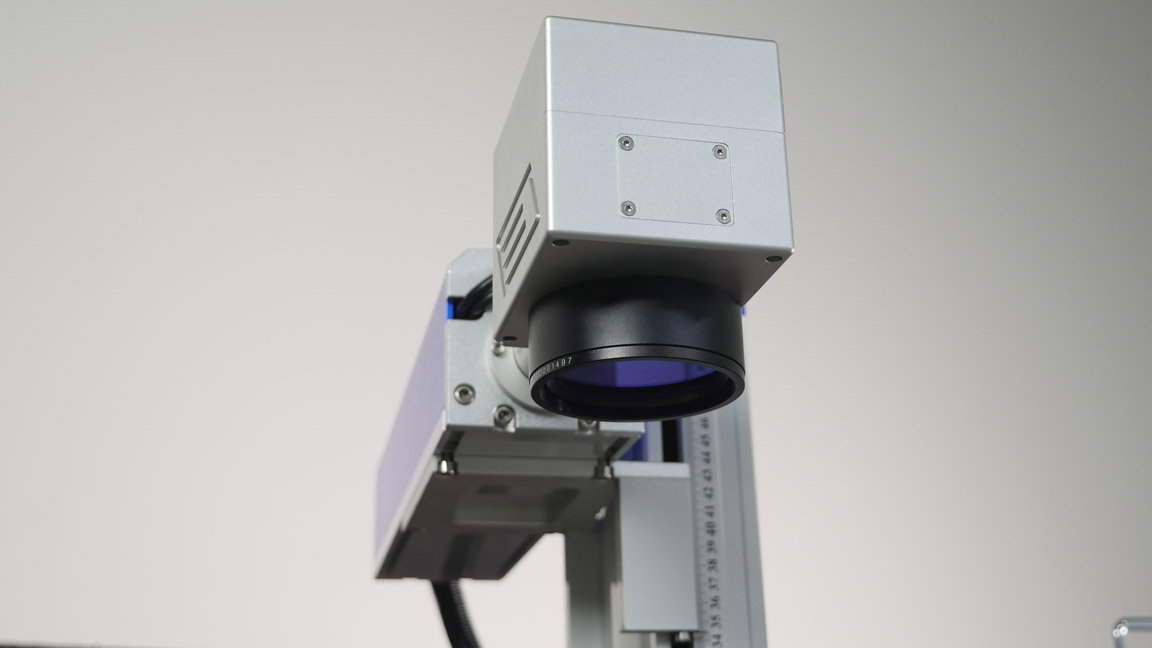
If you need fast and/or deep engraving, then you should choose a 110x110 mm lens and the most powerful emitter.
Using a 300x300 mm lens with 20 W power is pointless for engraving. But this is a good option for marking, e.g. coloured shades, if the emitter has a wide frequency range.
It is worth having several lenses for different tasks. If you have a laser marker with 3 lenses, this means you have 3 different markers, as they can perform different tasks.
Marking machine design
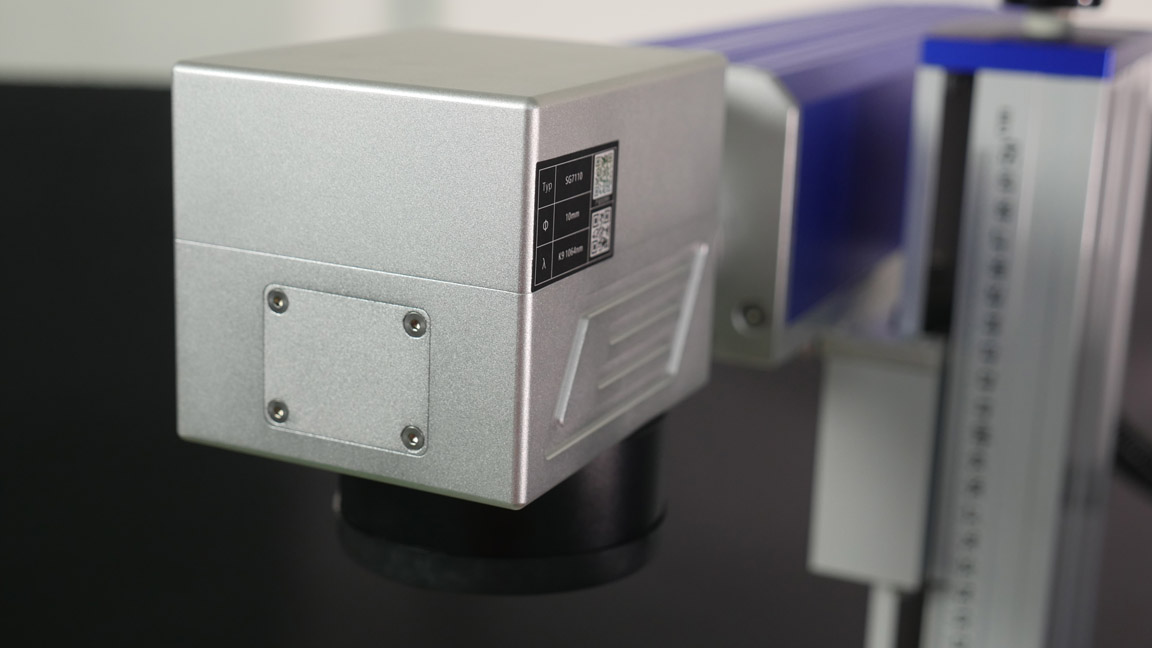
Laser marking machines work on the same principle, but they can have different designs and different focusing methods.
To focus, you need to adjust the distance between the scanner and the material. There are 3 ways to do this.
3 focus options:
- movable table. On machines with a static scanner, the focus is set with a small movable table with adjustable height, for example the Wattsan СО2 LT or the Wattsan FL LT.
- movable vertical axis is a stand, on which the scanner is mounted and which moves up and down manually by rotating a special wheel, e.g. the Wattsan FL TT.
- auto focus has the same mechanism as the movable vertical axis, only the scanner finds the right position automatically when the button is pressed before starting work (only possible with metal materials). Can be installed on the Wattsan FL TT.
There is also dynamic autofocus, which is capable of changing the focal length during the operation and is used for engraving materials of complex shapes. This option costs significantly more and is rarely used. If you need such a solution, please contact our managers: +31208082045 or е-mail: info@virmer.com.
Let us go back to the machine design; different solutions are used for different tasks.
Types of laser marker body
- Standard marker has a universal design and can be placed on a conventional table. Suitable for both production and hobby applications. For example, the Wattsan CO2 LT or the Wattsan FL TT and the Wattsan FL LT.
- Marking station is immediately equipped with a convenient desk, inside which all the electronics are housed. A work computer can also be installed there. The table has a panel with control buttons and a convenient drawer. This machine is easy and convenient to integrate into a production line. For example, the Wattsan FL ST.
- Machine with a safety cabin is required when using the laser marker in safety-sensitive areas, such as educational institutions or shopping centers. For example, the Wattsan FL TT Box
- Portable laser marker has a portable scanner with a long cable. Can engrave and mark in hard-to-reach places and on heavy or oversized objects. For example, the Wattsan FL HH.
Scanner and controller
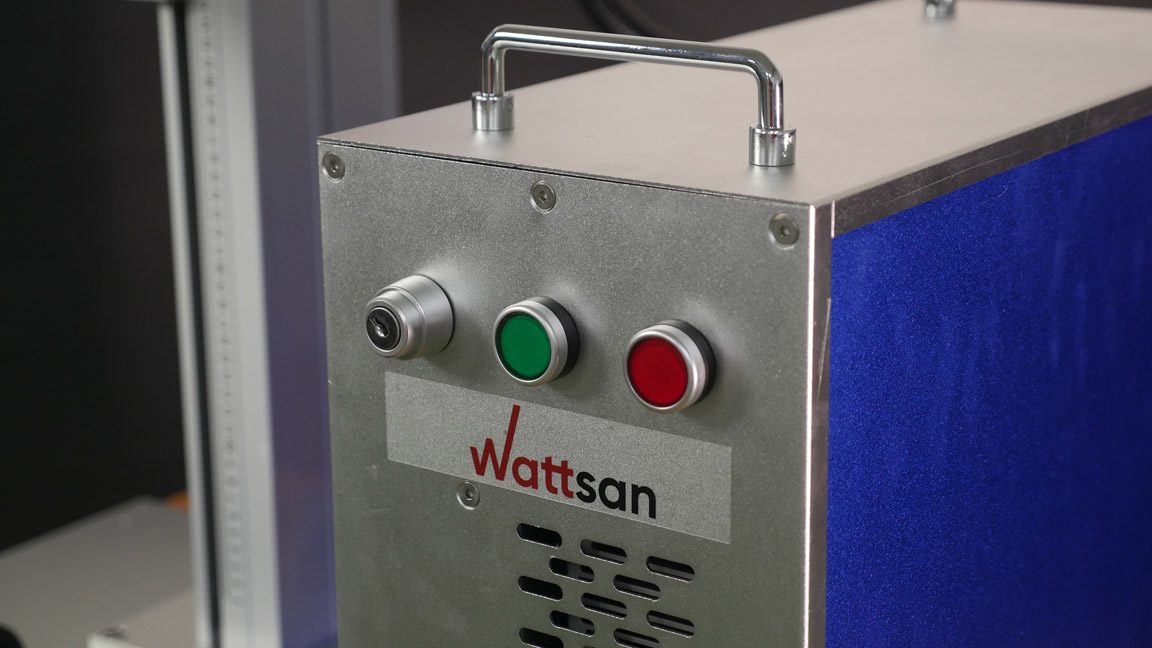
The sino-galvo high-speed galvanometer directs the laser beam by means of two moving mirrors; the speed and, most importantly, the accuracy of the operation depend on it. And the controller is the board that manages the whole process and controls the laser source and scanner.
These machine parts are not easy to determine the parameters for selection especially if you are not technically versed in the matter. Therefore, the most important thing to know about the scanner and controller is that they must be original. This is necessary in order to exploit the emitter's potential and use the full functionality of the software.
Wattsan only uses original controllers and scanners on its laser marking machines.
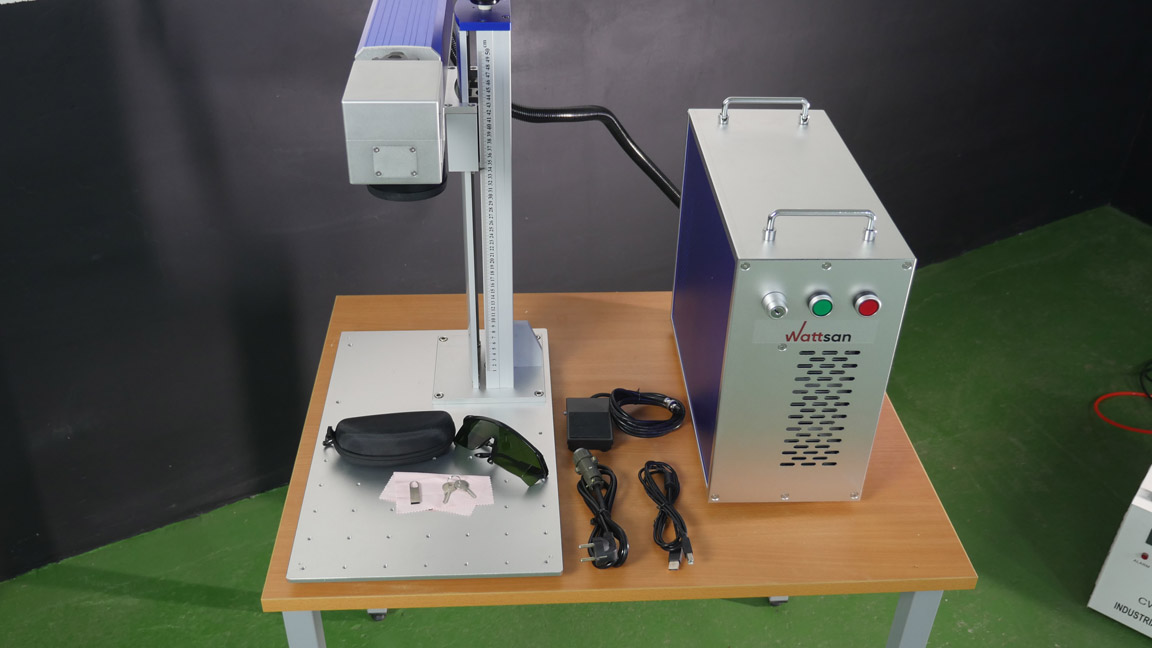
The manufacturer supplies its laser markers with the EZ CAD software, which offers a wide range of functions:
- You can create graphic objects;
- Supports major raster and vector formats;
- Can make bar-codes and QR-codes;
- Supports a variety of font types;
- Supports Excel data;
- Can handle curves;
- Available in different languages;
- Has many tools;
- 265 colours for assigning different marking modes and many other functions.
Supplier support, service, and reliability
The last thing to consider when choosing a laser marker is the supplier.
You need to make sure you get:
- Commissioning assistance;
- Training on working with a machine and software;
- Advice and answers to your questions;
- Warranty.
This is all offered by Virmer. If you need help choosing a laser marker or you would like to know more about working with us, contact our managers for detailed advice, phone: +31208082045 or е-mail: info@virmer.com.
See our website for a complete list of laser marking machines.
FAQ
How much does a laser marker cost?
The cost of the marking equipment depends on the intended use of the machine, its power, and options. Price ranges from €3,650 to €7,550, see more details on our website.
How long does a laser marking last?
It is a permanent image resistant to mechanical damage, acidic and alkaline media, high and low temperatures.
Which fiber laser marker is better?
It depends on your application. The main selection criterion is the emitter power and the lens. For quick deep engraving or working on highly reflective metals, it is better to use emitters with a power of 50W and a lens with a working area of 110x100mm. For high quality marking a 20-30W emitter and a 200x200 or 300x300 mm lens will do the trick. For more details, please contact Virmer managers: +31208082045 or е-mail: info@virmer.com.
Which laser marker is best for hobbies?
For the hobby, budget markers with MaxPhotonics or Raycus emitters are suitable. However, if your hobby is jewellery making, you should consider machines with IPG emitters from 50W. For more details, please contact Virmer managers: +31208082045 or е-mail: info@virmer.com.
Which materials can a laser marker mark?
CO2 laser sources mark and engrave organic materials: plywood and all types of wood-based materials, paper and cardboard, leather and faux leather, fabric, glass and mirror, plastics and rubber, stone and ceramics. Fiber emitters mark and engrave metals (ferrous metals, stainless steel, aluminium, titanium, etc), plastics and rubber, leather and faux leather.
